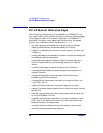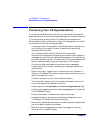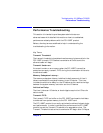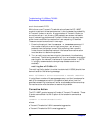
52 Chapter5
10/100Base-TX Resources
Contacting Your HP Representative
Contacting Your HP Representative
If you have no service contract with HP, you may follow the procedure
described below, but you will be billed accordingly for time and materials.
If you have a service contract with HP, document the problem as a
Service Request (SR) and forward it to your HP representative. Include
the following information where applicable:
• A characterization of the problem. Describe the events leading up to
and including the problem. Attempt to describe the source and
symptoms of the problem.
Your characterization should include: HP-UX commands;
communication subsystem commands; job streams; result codes and
messages; and data that can reproduce the problem. You should also
provide a network map with the host name, IP/Internet address, and
station address of each system connected with the HP system.
Illustrate as clearly as possible the context of any message(s).
Prepare copies of information displayed at the system console and
user terminal.
• Obtain the version, update, and fix information for all software. To
check the 10/100Base-TX version number, execute what vmunix and
look for the keyword, vtlan1.
To check the version of your kernel, execute uname -r.
This allows HP to determine if the problem is already known and if
the correct software is installed at your site.
• Prepare copies of the /etc/hosts, and /etc/rc.config.d/netconf files.
• Execute the dmesg command and record messages about the status of
the 10/100Base-TX card.
• Execute the lanscan -v command and record the output.
• Execute the display command of the lanadmin diagnostic on the
10/100Base-TX interface and record the output.
• Record the troubleshooting flowchart number and step number where
you are unable to resolve the problem.
• Record all error messages and numbers that appear at the user
terminal and the system console.


















